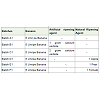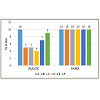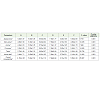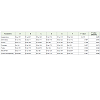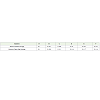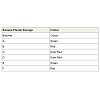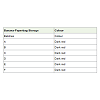Research Article
Comparative Study on the Ripening Ability of Banana by Artificial Ripening Agent (Calcium Carbide) and Natural Ripening Agents
Surbhi Gandhi*, Mahak Sharma, Barkha Bhatnagar
Department of Nutrition & Dietetics, Manav Rachna International University, Faridabad, Haryana
Corresponding author: Surbhi Gandhi, Department of Nutrition & Dietetics, Manav Rachna International University,Faridabad, Haryana, Ph no: 9911368157; E-mail: Surbhigandhi420@gmail.com
Citation: Gandhi S, Sharma M, Bhatnagar B. Comparative Study on the Ripening Ability of Banana by Artificial Ripening Agent (Calcium Carbide) and Natural Ripening Agents. Indian J Nutri. 2016;3(1): 127.
Copyright © 2016 Gandhi S, et al. This is an open access article distributed under the Creative Commons Attribution License, which permits unrestricted use, distribution, and reproduction in any medium, provided the original work is properly cited.
Indian Journal of Nutrition | ISSN: 2395-2326 | Volume: 3, Issue: 1
Submission: 24/05/2016; Accepted: 29/06/2016; Published: 05/07/2016
Abstract
Ripening is defined as the final stage of development of a fruit which involves series of physiological and biochemical events leading to various changes in colour, flavour, aroma and texture that make the fruits both attractive and tasty. In recent times there is much concern about artificial ripening. Various artificial methods of fruit ripening have been observed mostly to meet consumers’ demand and other economic factors. People consume fruits, ripened with hazardous chemicals like calcium carbide. These pose great health risks to consumers. Therefore, the present study was designed to compare natural ripening agents apple,pear,tomato) with artificial ripening agent (calcium carbide) for ripening of banana. Different Batches of banana were made with natural ripening agents& calcium carbide (1 gm and 2 gm). The ripening ability was assessed by keeping the batches in two different storage conditions i.e. paper bag & plastic container. Sensory evaluation was done both by Hedonic scoring. The data revealed that bananas kept in plastic container ripened before those placed in paper bags and were more acceptable. Moreover, bananas placed in containers with apples took only 4 days to ripen whereas those placed with calcium carbide at bothconcentrations took 5 days. The study concluded that natural ripening agents especially Apple are better as compared to artificial ripener. Also, they are devoid of any potential health risks for the adolescents & adults.
Keywords: Artificial ripening; Calcium carbide; Natural ripening agents; banana
Introduction
The major fruits grown in these countries are banana, mango,citrus, pineapple and papaya. Besides these, a large number of minorfruits are also grown in the region such as black berry, tamarindetc. Fruits are oftenly procured unripe so that spoilage duringtransportation & storage can be avoided. In recent times there ismuch concern about artificial ripening of fruits in many parts of theworld [1].
Ripening
Ripening is defined as the final stage of development of a fruitwhich involves series of physiological and biochemical events leading to various changes in colour, flavour, aroma and texture that makethe fruits both attractive and tasty. During ripening, the starch inthe fruit breaks down to sugar. The fruit skin colour changes greento bright red or yellow. These changes attract birds, animals andconsumers. The ripening of a fruit depends on the season [2]. Fruitripening is a highly controlled and programmed developmental event,involving the co-ordination of a multitude of metabolic changes andinvolves the activation and inactivation of various genes leading tobiochemical and physiological changes within the tissue [3-6]. Fruitsmay be classified as climacteric or non-climacteric depending onits respiration rate. Climacteric fruits are characterized by transientincrease in both ethylene synthesis and respiration at an early stage of ripening. The peak of ethylene production rate is proportional to thepeak respiration rate. Fruit softening, colour changes, developmentof taste and flavour and a number of other parameters of ripeningprocess are associated with the climacteric cycle. The climactericfruits are avocado, banana, cherimoya, mango, kiwifruits, apple,apricot, cucurbit, jackfruit, papaya, peach, pear, plum and tomato.Non- climacteric fruit does not show any increase in respirationand ethylene synthesis during ripening. In fact, non-climactericfruits show decline in their respiration rate and ethylene productionthroughout the ripening process. Non-climacteric fruits are citrusfruits, cherry, cucumber, grape, lemon, orange, pepper, pineapple,strawberry, etc [7].
Artificial Ripening
In recent times there is much concern about artificial ripening.Various artificial methods of fruit ripening have been observedmostly to meet consumers’ demand and other economic factors.People consume fruits, ripened with hazardous chemicals likecalcium carbide. These pose great health risks to consumers [8].Fruit sellers artificially ripen green fruits even during the due seasonto meet the high demand and make high profit of seasonal fruits.Transporting and distributing fruits from the farmers’ orchardsto consumers’ baskets can take several days. During this time thenaturally ripened fruits may become over ripen and inedible. Apart of naturally ripened fruits can also be damaged during harshcondition of transportation. It indeed increase great economic lossfor the fruit sellers and therefore, to minimize the loss, fruit sellerssometimes prefer collecting fruits before full maturity and artificiallyripen fruits before selling to the consumers [9].
Chemicals used in Fruits
The use of chemicals in food is an issue of major concern. Fruitsare highly nutritious and form an important food item in the humandiet. On the other hand these are highly perishable due to their shortshelf life. These food commodities are contaminated with toxic andhealth hazardous chemicals like calcium carbide, ethylene whichare being used for ripening fruits and protecting them from rottenand damage. Moreover, formalin and some other chemicals are alsoused for extending the shelf life of fruits which are reported to cause several health problems like such as dizziness, weakness, ulcer, heartdisease, skin disease, lung failure, kidney failure and cancer etc. Thewidespread use of formalin and other chemicals for preservation offruits has become a great concern among the people. The chemicalsused as spray solution make fruits attractive [10].
Calcium carbide
Calcium carbide (available as greyish black powder) iscommercially intended for welding purpose but its use in theartificial ripening of climacteric fruits is rampant in many developingcountries. Calcium carbide, once dissolved in water, producesacetylene which acts as an artificial ripening agent. Fruits ripened withcalcium carbide are soft and have good peel colour development butare poor in flavour. Calcium carbide, popularly known as masala, isused extensively in mangoes, bananas and papayas and sometimes inapples and plums. Being cheap (one kg of this chemical costs Rs. 25-30, which can ripen 20 tonnes of fruit), it is indiscriminately used bythe traders in preference to other recommended practices of inducingripening like dipping fruits in a solution of ethephon, or exposure offruits to ethylene gas [11].
However, treatment of fruits with calcium carbide is extremelyhazardous because the chemical is known to contain traces of arsenicand phosphorous. Acetylene gas produced by calcium carbidemay affect the neurological system by inducing prolonged hypoxiagradually culminating to headache, dizziness, mood disturbances,sleepiness, mental confusion, memory loss, cerebral edema andseizures [11].
As per the rule 44 AA of the Prevention of Food AdulterationRules 1955 “No person shall sell or offer or expose for sale or have inhis premises for the purpose of sale under any description, fruits whichhave been artificially ripened by use of acetylene gas, commonly knownas carbide gas.†In spite of such a restriction, calcium carbide is oftenutilized as a ripening agent in commercial front [12].
Methodology
The study was divided into 4 phases. Phase I includes procurement& selection of fruits. The unripe fruits i.e. banana were procuredfrom the local market of Dabua colony, Faridabad. Unripe bananawith uniform peel colour and size were selected. Ripe bananas wereexcluded. Natural ripening agents i.e. apple, pear and tomato wereprocured from the local market of Dabua colony, Faridabad. The fruitswere selected on the basis of ethylene production. Unripe fruits werenot included as ripening agents. Also bruised fruits were not used inthe experiment. Calcium carbide was procured by the local chemicalvendor from N.I.T 5 local market, Faridabad. The phase II involvedexperimentation & observation. Six bunches of unripe banana werelabelled as A,B,C,D,E,F containing 5 bananas each were exposed tosimilar environmental conditions. These batches were exposed totwo different storage conditions i.e. plastic container & paper bag.
These were exposed to varying amounts & types of ripening agents.Thus while batch A was allowed to ripen naturally, batch B & C wereexposed to 1gram & 2gram calcium carbide respectively. Batch Dwas exposed to single apple while batch E & F were exposed to singletomato & pear respectively (Table 1). Change in the skin-colour fromgreen to yellow was considered as the stage for the ripening of fruit.Phase III includes, subjective evaluation, which was done to assess theripening ability of different batches. Hedonic scoring methods wereused in the sensory evaluation of bananas. For sensory evaluationprecautions were taken as recommended by FSSAI, the banana waspealed and then sensory evaluation was done. Objective evaluationwas also done by assessing the titrable acidity and performingBenedict’s test. Phase IV includes statistical analysis, SPSS version 20was used to assess mean, standard deviation and ANOVA.
Precaution - Fruits were pealed and washed thoroughly withwater before sensory evaluation.
Results and Discussion
It was observed that the batches stored in plastic container differin the ripening ability. The banana stored in batch A took 10 daysto ripen while batch B & C took 5 days respectively. Batch D took 4days while E & F took 7 & 9 days respectively. Those batches storedin paper bags took 10 days to ripen. Ripening was similar in all thebatches of paper bag storage (Figure 1).
Sensory evaluation revealed (Table 2) that bananas stored withapple (batch D) were the most acceptable in plastic container storage.However no significant differences were observed in the differentbatches stored in paper bag storage. Hedonic scoring was done tocollect the data.
Table 2 showed mean acceptability score of attributes between thebatches. In regard to appearance, there was a statistically significantdifference (P< 0.05) between the batches as determined by one-wayANOVA. Batch D had the highest mean value i.e. 7.40±1.77 whereasbatch E had lowest mean value i.e. 3.90±1.85. Thus batch D was mostacceptable.
Batch D had the highest mean value for skin-colour i.e. 7.50±2.01whereas Batch E had lowest value 2.70±1.63. Thus batch D was mostacceptable. The difference was statistically significant (P< 0.05) among batches.
The aroma had highest mean value for batch D i.e. 7.10±1.37 &lowest for batch E. Thus batch D was most acceptable. The differencewas statistically significant (p-value< 0.05) among batches.
Batch D had the highest mean value for firmness i.e. 7.40±1.50whereas Batch E had lowest value i.e. 2.90±1.10. Thus batch D wasmost acceptable in firmness. The difference is statistically significant(P< 0.05).
For taste, batch D had highest mean value i.e. 7.90±0.99 whereasbatch E had lowest value i.e. 2.10±1.28. Thus batch D was mostacceptable. The differences are statistically significant (P< 0.05)among groups.
For mouth-feel, batch D had highest mean value i.e. 7.60±1.26whereas batch A had lowest value i.e. 2.40±1.71. Thus batch D wasmost acceptable. The differences are statistically significant (P< 0.05)among groups.
The overall acceptability was highest for batch D with meanvalue of 7.90±0.99, however it was lowest for batch E. Thus batch Dwas overall most acceptable. The difference is however statisticallysignificant (P< 0.05).
Batch D was most acceptable regarding all the attributes as wellas the overall acceptability was also higher in batch D as compared toother batches.
Table 3 showed the mean acceptability score of attributes betweenthe batches. In appearance, there was a statistically insignificantdifference between the batches (P=0.955) as determined by one-wayANOVA. Batch D & E had the highest mean values whereas batch Bhad lowest mean value i.e. 5.1±2.07.
Batch D had the highest mean value for skin-color i.e. 5.9±1.79whereas Batch A& F had the lowest value 5.1±1.72 but the differenceswere statistically not significant among batches (P=0.842).
The aroma had highest mean value for batch E i.e. 6±1.56 & lowestfor batch A i.e. 5.5±1.71. The difference was however, statistically notsignificant among batches (P=0.991).
Batch D had the highest mean value for firmness i.e. 5.9±1.72whereas Batch A had lowest value i.e. 5±1.41 but the differences werestatistically not significant among batches (P=0.673).
For taste, batch E had highest mean value i.e. 6.2±1.31 whereasbatch A had lowest value i.e. 5.2±1.61 but the differences werestatistically not significant (P=0.499).
For mouth-feel, batch C had highest mean value i.e. 6±1.05whereas batch B had lowest value i.e. 5.1±1.96 but the differences were statistically not significant among batches (P=0.753).
The overall acceptability was highest for batch C with mean valueof 6±1.33, however it was lowest for batch B i.e. 5.3±2.05 but thedifferences were statistically not significant among batches (P=0.886).
Sensory evaluation revealed (Table 1) that bananas stored withapple (batch D) were the most acceptable in plastic container storage.However, no significant differences were observed in the differentbatches stored in paper bag storage.
Objective evaluation
A) Titrable Acidity
Table 4 showed the titrable acidity of different batches underdifferent storage conditions. In banana-plastic storage batch D i.e.0.16 had the highest titrable acidity while batch A had the lowestacidity i.e. 0.1. In banana-paper bag storage, Batch E had the highesttitrable acidity i.e. 0.117 while batch A had the lowest titrable acidityi.e. 0.1.
Benedict’s test
Table 5 showed that the Benedict’s test gives dark red colourin both Batches C & D that means these have the highest contentof reducing sugars and thus are ripened. Batches A& E showedgreen colour with Benedict’s test which means that these are low inreducing sugars & thus are unripe. Batches B & F show red colourwith Benedict’s reagent which means these have moderate reducingsugar content and thus are partially ripe. Thus batches C & D weremost acceptable as they were fully ripened.
Table 6 showed that the colour of all the batches is somewhatsimilar which shows that all the batches contain reducing sugars andthus are ripe.
Conclusion
The present study indicates that apple can be used as a ripeningagent for banana as it can reduce the ripening time. Apple ripenedthe banana 1 day before calcium carbide so it can be consideredas an effective ripening agent as compared to the other natural &artificial ripening agents. Use of apple as a ripening agent for bananacan eliminate the potential health risks caused by the use of calciumcarbide. Also it was observed that plastic storage was better ascompared to paper bag storage as paper is gas permeable.
References
- Hossain MF, Akhtar S and Anwar M (2015) Health hazards posed by the consumption of artificially ripened fruits in Bangladesh. Int Food Res J 22: 1755-1760.
- Rahman AU, Chowdhury FR, Alam MB (2008) Artificial ripening: What We Are Eating? J Medicine 9: 42-44.
- Clendennen SK, May GD (1997) Differential gene expression in ripening banana fruit. Plant Physiol 115: 463-469.
- Marin-Rodriguez MC, Smith DL, Manning K, Orchard L and Seymour SB (2003) Pectate lyase gene expression and enzyme activity in ripening banana fruit. Plant Mol Biol 51: 851-857.
- Drury R, Hörtensteiner S, Donnison I, Bird CR, Seymour GB (1999) Chlorophyll catabolism and gene expression in the peel of ripening banana fruits. Physiol Plant 107: 32-38.
- Itai A, Tanabe K, Tamura F, Tanaka T (2000) Isolation of cDNA clones corresponding to genes expressed during fruit ripening in Japanese pear (Pyrus pyrifolia Nakai): involvement of the ethylene signal transduction pathway in their expression. J Exp Bot 51: 1163-1166.
- Gray J, Picton S, Shabbeer J, Schuch W, Grierson D (1992) Molecular biology of fruit ripening and its manipulation with antisense genes. Plant Mol Biol l: 69-87.
- Rahim MA (2012) In discriminate use of chemical in fruits and their health effects. In proceedings of First AFSSA Conference on Food Safety and Food Security held at Osaka Prefecture University, Osaka, Japan.
- Mursalat M, Rony AH, Rahman AH, Islam MN, Khan MS (2013) A critical analysis of artificial fruit ripening: Scientific, Legislative and Socio-Economic Aspects. Che Thoughts-Chemical Engineering and Science Magazine 4: 6-12.
- Singal S, Kumud M, Thakral S (2012) Application of apple as ripening agent for banana. Indian Journal of Natural Products and Resources 3: 61-64.
- Per H, Kurtoğlu S, Yağmur F, Gümüş H, Kumandaş S, et al. (2007) Calcium carbide poisoning via food in childhood. J Emerg Med 32: 179-180.
- The Prevention of Food Adulteration Act, 1954 along with the Prevention of Food Adulteration Rules, 1955.

